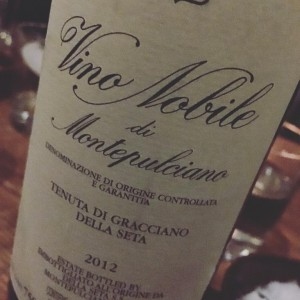News & Events
6 June 2016
The new (old) wines of Vino Nobile di Montepulciano
An interesting article of the US blogger Taylor Eason on Vino Nobile di Montepulciano with a beautiful review for our Vino Nobile 2012

It ain’t easy being the underdog. When you have Chianti and Brunello as your big brothers and Super Tuscans as your sophisticated sister, Vino Nobile di Montepulciano has to do a lot to get attention. Add to that some pretty tough Italian regulations about growing, blending and a helluva long name, it’s been a tough marketing road for this small, 76-producer, sub-region of Tuscany. But they’re making a delicious go of it with Sangiovese as the king pin.
Established in 1966, the Vino Nobile di Montepulciano DOC (Denominazione di Origine Controllata) is comprised of 3,100 planted acres in the southeastern section of Tuscany, about 65 kilometers south of Siena. But grapes and wine have been in this region for millennia, with documents proving vineyards dating back to 790 AD. In 1980, the region was awarded a G on the DOC (Denominazione di Origine Controllata e Garantita), making them among the elite wine growing regions in Italy.
This year marks their 50th anniversary of being recognized with quality Italian wine.
The teensy geographical size and small number of producers in Vino Nobile di Montepulciano (now shortened to just “Nobile” on wine bottles, for obvious reasons) places them firmly in the hipster category of “artisan.” And the “baby” version of the Nobile, called Rosso, is so affordable that most hipsters can afford it too. Carpineto, a producer who makes wines all over the Tuscany region, offers their 100 percent Sangiovese 2014 Rosso at $15 a bottle, a complete steal for the quality, round red fruit and food-friendliness. This family-run winery was founded in 1967 and owns 250 acres in Nobile. I tried their 2010 Vino Nobile di Montepulciano Riserva ($35) and a pretty stellar 1988 which gushed forth with mushrooms, truffles and black fruit.
The region requires at least 70 percent of the grapes grown on an estate in Vino Nobile di Montepulciano to be Sangiovese, the Purgnolo Gentile clone, and 30 percent can be other varietals like Canaiolo (red), Trebbiano (white), Malvasia (white) and Mammolo (red). Most producers in the region make both the Nobile Riserva DOCG and a Rosso di Montepulciano DOC, to cover their price bases and, after trying about 30 wines from the region, I learned that quality at one level indicates even better quality the higher level. So once you find a winery that you love, you’re pretty much guaranteed a mind-blowing experience if you spend $15-$20 more. By Italian law, the Riserva DOCG level must spend three years oak aging and six months in bottle before release so they basically age it for you. Nice, huh? The Rossos are only aged around six -12 months and are meant to be grogs. But they’re a helluva lot better than most reds coming out of California after six months — much more complexity, structure and quality for the $15-$20 price.
Crociani is another noteworthy producer that offered up elegance, sophistication and good acidity in all their wines. Their 2010 Riserva was less tannic than others of the same vintage, with dark chocolate, black cherry and a dusty finish. I would even call it pretty. Tenuta di Gracciano Della Seta presented the one of the few 2012 vintages of the evening — a year rated five stars by the Italian government — and their 90 percent Sangiovese, 10 percent Merlot Vino Nobile was absolutely stunning. Perfectly balanced acids and tannins, with plenty of fruit to bring it together. In the 2014 Rosso from Vecchia Cantina di Montepulciano, they blend in some Canaiolo which smooths out any rough edges and provides a floral character, structure and color. And a producer called Le Bèrne has a completely gorgeous 2014 Rosso with approachable acids, mild tannins and dark fruit like plum and blackberry.
I can safely say that most of the Rossos I tasted were the yin to the Riserva’s yang.
With super quality wines like these and with prices that so many people can afford, the only thing holding back Vino Nobile di Montepulciano from success in the U.S. is awareness (and that hella name they’re fixing). Go forth and explore these wines… they’re one of the few regions in Italy that hasn’t been priced out of the normal person’s shopping cart. Find them at enlightened wine shops and on sommelier-driven wine lists.
Taylor Eason